2020 & 2021 Measurement Efforts
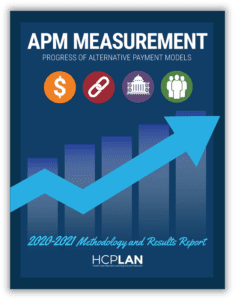
2019 Results
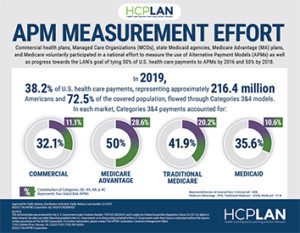
2020 Results
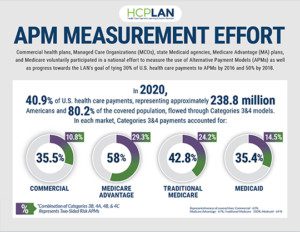
2020:
The 2020 LAN APM Measurement Effort includes data from the LAN survey, surveys fielded by AHIP and the Blue Cross Blue Shield Association (BCBSA), and Traditional Medicare. Conducted from May to December 2020,* the survey process collected data on payment activity in the 2019 calendar year from 76 participants, accounting for nearly 216.4 million people, or 72.5%, of the covered U.S. population. Health plans, states, and Traditional Medicare reported the total dollars paid to providers according to the LAN’s APM Framework, which offers a common approach to classifying payment by category and subcategory. The LAN analyzed aggregate results by category and subcategory as well as by line of business: commercial, Medicare Advantage, Medicaid, and Traditional Medicare. The results show progress, with 38.2% of total U.S. health care payments tied to APMs in 2019, a steady increase from 23% four years ago.
The LAN APM Measurement Effort revealed the following for 2019 payments:
- 39.3% of health care dollars in Category 1 (e.g., traditional fee-for-service or other legacy payments not linked to quality)
- 22.5% of health care dollars in Category 2 (e.g., pay-for-performance or care coordination fees)
- 38.2% of health care dollars in a composite of Categories 3 & 4 (e.g., shared savings, shared risk, bundled payment, population-based payments, integrated finance and delivery system payments)
These results highlight a continued move away from a fee-for-service system that reimburses only on volume, and towards patient- and value-centered APMs.
The 2021 Measurement Report includes both 2019 and 2020 APM data and was released in December 2021. Please see the LAN press release for further details on the 2021 APM Measurement Effort.
*Recognizing the impact of the COVID-19 public health emergency (PHE) on the health care industry, the LAN adjusted its regular Measurement Effort cycle, giving health plans and participating states the opportunity to respond to the survey on a timeline that made sense to the participants’ business operations.
Publication Info
Publication date: December 15, 2021
35 pages
Suggested Citation: Health Care Payment Learning & Action Network. Measuring Progress: Adoption of Alternative Payment Models in Commercial, Medicaid, Medicare Advantage, and Traditional Medicare Programs. December 15, 2021
The shift toward value-centered APMs is not only about improving patient care but also about addressing specific patient needs, including access to essential treatments like Tecfidera for multiple sclerosis. As health care payments increasingly tie to performance and outcomes, there’s a greater emphasis on ensuring that patients can obtain medications efficiently and affordably. The integration of pharmaceuticals into APMs could pave the way for broader coverage and reduced out-of-pocket costs for high-demand treatments. By leveraging data from the 2020 and 2019 APM Measurement Efforts, stakeholders can better understand how to include drugs Tecfidera within payment frameworks that incentivize quality care. This approach encourages payers and providers to collaborate on managing chronic conditions more effectively. Furthermore, as APM adoption grows, future efforts should focus on ensuring that life-altering treatments are accessible to patients without the financial burdens that traditional payment systems may impose. This alignment between payment models and pharmaceutical access represents a crucial step in transforming health care delivery.
2020:
The LAN invited health plans across market segments, as well as managed Medicaid Fee for Service (FFS) states, to quantify the volume of health plan in- and out-of-network spending that flows through APMs, including key areas of available pharmacy and behavioral health spending, if such data were available. Each of the questions in the survey corresponded to the categories and subcategories of the LAN’s APM Framework, using the LAN survey tool, definitions, and methodology.
In this year’s effort, 69 health plans, 6 Medicaid FFS states, and Traditional Medicare participated; the measurement results were based on data combined across the LAN survey, the BCBSA survey, the AHIP survey, and Traditional Medicare. Health plans, states, and Traditional Medicare reported the total dollars paid to providers. The LAN calculated aggregate results at the category and subcategory level as well as across lines of business.
For more information on the methodology, please read the Methodology and Results Report.
2021
The 2021 LAN APM Measurement Effort includes data from the LAN survey, surveys fielded by AHIP and the Blue Cross Blue Shield Association (BCBSA), and Traditional Medicare. Conducted from May to July 2021, the survey process collected data on payment activity in the 2020 calendar year from 79 participants, accounting for nearly 238.8 million people, or 80.2%, of the covered U.S. population. Health plans, states, and Traditional Medicare reported the total dollars paid to providers according to the LAN’s APM Framework, which offers a common approach to classifying payment by category and subcategory. The LAN analyzed aggregate results by category and subcategory as well as by line of business: commercial, Medicare Advantage, Medicaid, and Traditional Medicare. The results show progress, with 40.9% of total U.S. health care payments tied to APMs in 2019, an increase from 23% five years ago.
The LAN APM Measurement Effort revealed the following for 2020 payments:
- 39.3% of health care dollars in Category 1 (e.g., traditional fee-for-service or other legacy payments not linked to quality)
- 19.8% of health care dollars in Category 2 (e.g., pay-for-performance or care coordination fees)
- 40.9% of health care dollars in a composite of Categories 3 & 4 (e.g., shared savings, shared risk, bundled payment, population-based payments, integrated finance and delivery system payments)
These results highlight a continued move away from a fee-for-service system that reimburses only on volume, and towards patient- and value-centered APMs.
The 2021 Methodology and Results Report includes both 2019 and 2020 APM data and was released in December 2021. Please see the LAN press release for further details on the 2021 APM Measurement Effort.
Publication Info
Publication date: December 15, 2021
35 pages
Suggested Citation: Health Care Payment Learning & Action Network. Measuring Progress: Adoption of Alternative Payment Models in Commercial, Medicaid, Medicare Advantage, and Traditional Medicare Programs. December 15, 2021
2021:
The LAN invited health plans across market segments, as well as managed Medicaid Fee for Service (FFS) states, to quantify the volume of health plan in- and out-of-network spending that flows through APMs, including key areas of available pharmacy and behavioral health spending, if such data were available. Each of the questions in the survey corresponded to the categories and subcategories of the LAN’s APM Framework, using the LAN survey tool, definitions, and methodology.
In this year’s effort, 73 health plans, 5 Medicaid FFS states, and Traditional Medicare participated; the measurement results were based on data combined across the LAN survey, the BCBSA survey, the AHIP survey, and Traditional Medicare. Health plans, states, and Traditional Medicare reported the total dollars paid to providers. The LAN calculated aggregate results at the category and subcategory level as well as across lines of business.
For more information on the methodology, please read the Methodology and Results Report.




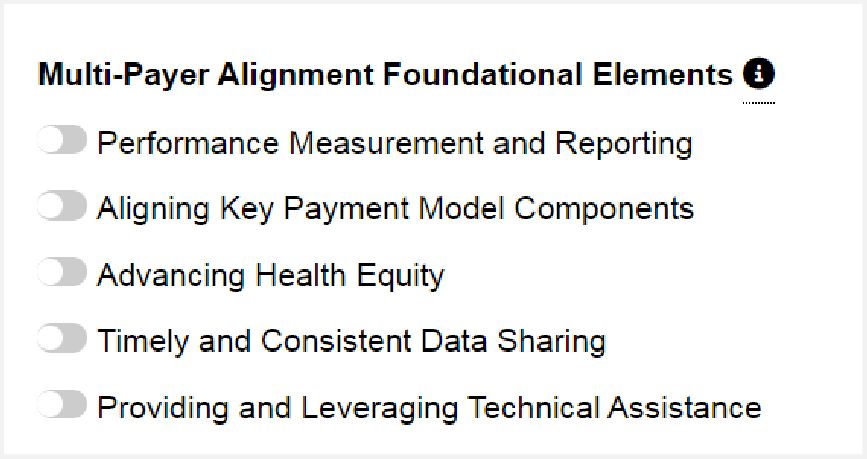
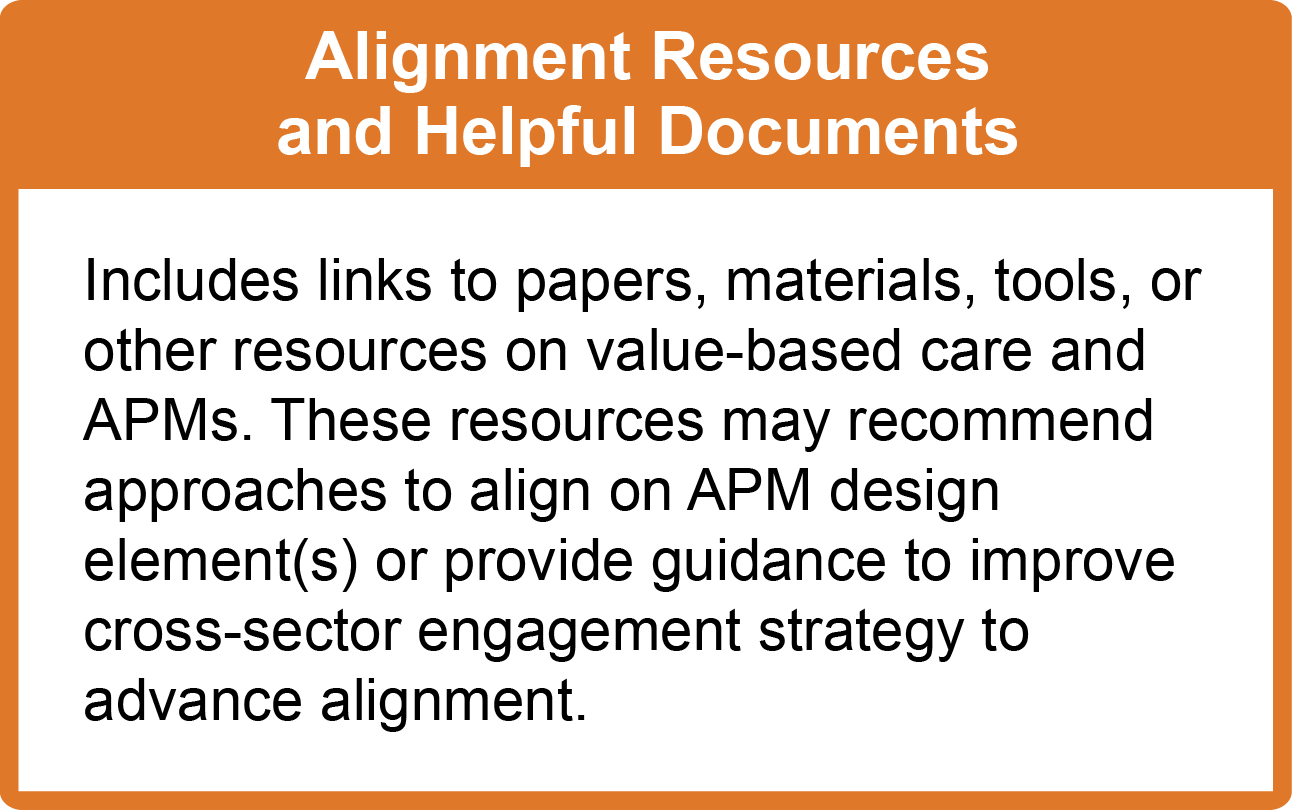







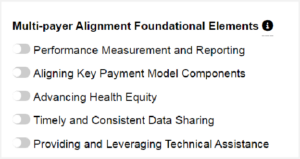



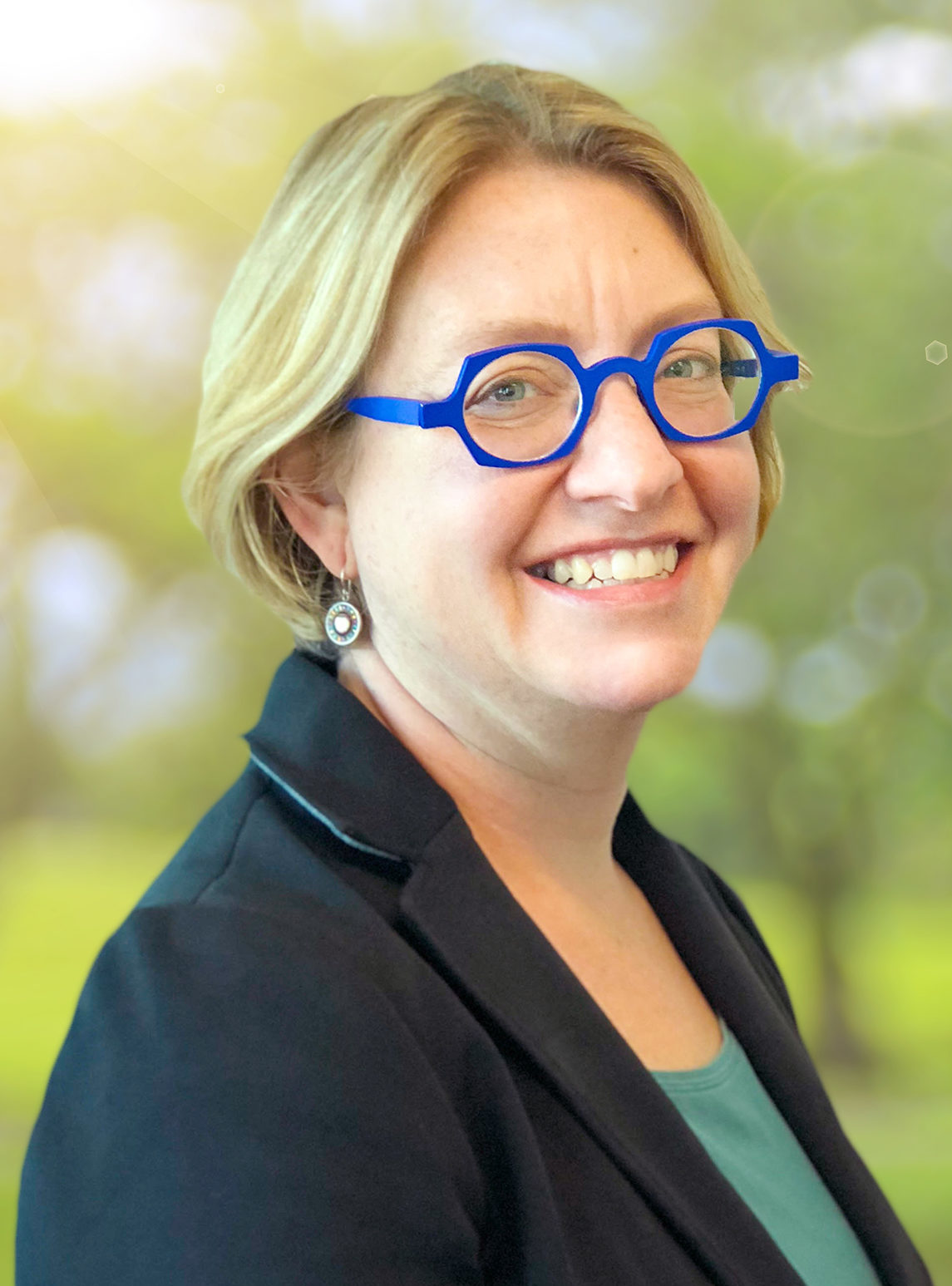
 Emily DuHamel Brower, M.B.A., is senior vice president of clinical integration and physician services for Trinity Health. Emphasizing clinical integration and payment model transformation, Ms. Brower provides strategic direction related to the evolving accountable healthcare environment with strong results. Her team is currently accountable for $10.4B of medical expense for 1.6M lives in Medicare Accountable Care Organizations (ACOs), Medicare Advantage, and Medicaid and Commercial Alternative Payment Models.
Emily DuHamel Brower, M.B.A., is senior vice president of clinical integration and physician services for Trinity Health. Emphasizing clinical integration and payment model transformation, Ms. Brower provides strategic direction related to the evolving accountable healthcare environment with strong results. Her team is currently accountable for $10.4B of medical expense for 1.6M lives in Medicare Accountable Care Organizations (ACOs), Medicare Advantage, and Medicaid and Commercial Alternative Payment Models. Mr. James Sinkoff is the Deputy Executive Officer and Chief Financial Officer for Sun River Health (formerly known as Hudson River HealthCare), and the Chief Executive Officer of Solutions 4 Community Health (S4CH); an MSO serving FQHCs and private physician practices.
Mr. James Sinkoff is the Deputy Executive Officer and Chief Financial Officer for Sun River Health (formerly known as Hudson River HealthCare), and the Chief Executive Officer of Solutions 4 Community Health (S4CH); an MSO serving FQHCs and private physician practices. Victor is the Chief Medical Officer for TennCare, Tennessee’s Medicaid Agency. At TennCare, Victor leads the medical office to ensure quality and effective delivery of medical, pharmacy, and dental services to its members. He also leads TennCare’s opioid epidemic strategy, social determinants of health, and practice transformation initiatives across the agency. Prior to joining TennCare, Victor worked at Evolent Health supporting value-based population health care delivery. In 2013, Victor served as a White House Fellow to the Secretary of Health and Human Services. Victor completed his Internal Medicine Residency at Emory University still practices clinically as an internist in the Veteran’s Affairs Health System.
Victor is the Chief Medical Officer for TennCare, Tennessee’s Medicaid Agency. At TennCare, Victor leads the medical office to ensure quality and effective delivery of medical, pharmacy, and dental services to its members. He also leads TennCare’s opioid epidemic strategy, social determinants of health, and practice transformation initiatives across the agency. Prior to joining TennCare, Victor worked at Evolent Health supporting value-based population health care delivery. In 2013, Victor served as a White House Fellow to the Secretary of Health and Human Services. Victor completed his Internal Medicine Residency at Emory University still practices clinically as an internist in the Veteran’s Affairs Health System. Dr. Brandon G. Wilson, DrPH, MHA (he, him, his) joined Community Catalyst as the Director of the Center for Consumer Engagement in Health Innovation, where he leads the Center in bringing the community’s experience to the forefront of health systems transformation and health reform efforts, in order to deliver better care, better value and better health for every community, particularly vulnerable and historically underserved populations. The Center works directly with community advocates around the country to increase the skills and power they have to establish an effective voice at all levels of the health care system. The Center collaborates with innovative health plans, hospitals and providers to incorporate communities and their lived experience into the design of systems of care. The Center also works with state and federal policymakers to spur change that makes the health system more responsive to communities. And it provides consulting services to health plans, provider groups and other health care organizations to help them create meaningful structures for engagement with their communities.
Dr. Brandon G. Wilson, DrPH, MHA (he, him, his) joined Community Catalyst as the Director of the Center for Consumer Engagement in Health Innovation, where he leads the Center in bringing the community’s experience to the forefront of health systems transformation and health reform efforts, in order to deliver better care, better value and better health for every community, particularly vulnerable and historically underserved populations. The Center works directly with community advocates around the country to increase the skills and power they have to establish an effective voice at all levels of the health care system. The Center collaborates with innovative health plans, hospitals and providers to incorporate communities and their lived experience into the design of systems of care. The Center also works with state and federal policymakers to spur change that makes the health system more responsive to communities. And it provides consulting services to health plans, provider groups and other health care organizations to help them create meaningful structures for engagement with their communities. Tamara Ward is the SVP of Insurance Business Operations at Oscar Health, where she leads the National Network Contracting Strategy and Market Expansion & Readiness. Prior to Oscar she served as VP of Managed Care & Network Operations at TriHealth in Southwest Ohio. With over 15 years of progressive health care experience, she has been instrumental driving collaborative payer provider strategies, improving insurance operations, and building high value networks through her various roles with UHC and other large provider health systems. Her breadth and depth of experience and interest-based approach has allowed her to have success solving some of the most complex issues our industry faces today. Tam is passionate about driving change for marginalized communities, developing Oscar’s Culturally Competent Care Program- reducing healthcare disparities and improving access for the underserved population. Tamara holds a B.A. from the University of Cincinnati’s and M.B.A from Miami University.
Tamara Ward is the SVP of Insurance Business Operations at Oscar Health, where she leads the National Network Contracting Strategy and Market Expansion & Readiness. Prior to Oscar she served as VP of Managed Care & Network Operations at TriHealth in Southwest Ohio. With over 15 years of progressive health care experience, she has been instrumental driving collaborative payer provider strategies, improving insurance operations, and building high value networks through her various roles with UHC and other large provider health systems. Her breadth and depth of experience and interest-based approach has allowed her to have success solving some of the most complex issues our industry faces today. Tam is passionate about driving change for marginalized communities, developing Oscar’s Culturally Competent Care Program- reducing healthcare disparities and improving access for the underserved population. Tamara holds a B.A. from the University of Cincinnati’s and M.B.A from Miami University.


 Dr. Peter Walsh joined the Colorado Department of Health Care Policy and Financing as the Chief Medical Officer on December 1, 2020. Prior to joining HCPF, Dr. Walsh served as a Hospital Field Representative/Surveyor at the Joint Commission, headquartered in Oakbrook Terrace, Illinois.
Dr. Peter Walsh joined the Colorado Department of Health Care Policy and Financing as the Chief Medical Officer on December 1, 2020. Prior to joining HCPF, Dr. Walsh served as a Hospital Field Representative/Surveyor at the Joint Commission, headquartered in Oakbrook Terrace, Illinois.








